NASA: 'There's your new spacecraft, America!"
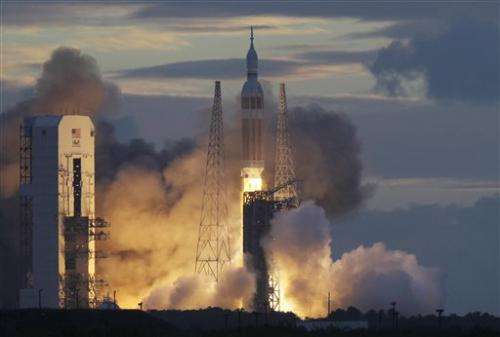
(AP)—NASA's newest space vehicle, Orion, accomplished its first test flight with precision and pizazz Friday, shooting more than 3,600 miles (5,800 kilometers) out from Earth for a hyperfast, hot return not seen since the Apollo moon shots.
For a space agency still feeling the loss of its shuttles, the four-hour voyage opened a new era of human space exploration, with Mars as the plum. It even brought some rocket engineers to tears.
"There's your new spacecraft, America," Mission Control's Rob Navias said as the unmanned Orion capsule came in for a Pacific splashdown after two orbits of Earth.
NASA is counting on future Orions to carry astronauts out into the solar system, to Mars and beyond.
The next Orion flight, also unmanned, is four years off, and crewed flights at least seven years away given present budget constraints. But the Orion team—spread across the country and out in the ocean, is hoping Friday's triumphant splashdown will pick up the momentum.
"We challenged our best and brightest to continue to lead in space," lead flight director Mike Sarafin said with emotion as he signed off from Mission Control in Houston. "While this was an unmanned mission, we were all on board Orion."
W. Michael Hawes, a former NASA official who now leads the Orion program for prime contractor Lockheed Martin Corp., choked up as he recalled the pre-shuttle days.
"We started with all the Apollo guys still there. So we've kind of now finally done something for the first time for our generation," he said.
Orion splashed down 270 miles (435 kilometers) off Mexico's Baja peninsula. Navy ships quickly moved in to transport the crew module 600 miles (970 kilometers) to San Diego, where it was expected Monday. From there, it will be loaded onto a truck and returned to Cape Canaveral just in time for Christmas.
Preliminary test reports were encouraging: Not only did the capsule arrive intact, all eight parachutes deployed and onboard computers withstood the intense radiation of the Van Allen belts surrounding Earth. What's more, everything meant to jettison away did so as Orion soared into space.
"It's hard to have a better day than today," said a beaming Mark Geyer, NASA's Orion program manager.
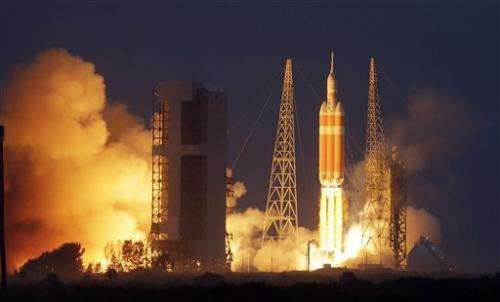
Sensors placed inside and out of the crew module will tell the full story: "Our big focus now is to get that data from those 1,200 sensors so they can pore over it in the next month or so," Geyer said.
Most critical was the heat shield covering Orion's bottom, the largest of its kind ever made. NASA wanted to be sure it would hold before committing to a human mission.
Orion reached a peak altitude of 3,604 miles (5,800 kilometers), higher than any crew module since NASA's final manned moon mission, Apollo 17, in 1972. That's more than 14 times higher than the International Space Station.
The capsule came in over the Pacific at 20,000 mph (32,200 kph) and endured 4,000 degrees. In just 11 minutes, it slowed to 20 mph (32 kph) for splashdown. A crew would have endured as much as 8.2 Gs, or 8.2 times the force of Earth gravity, double the Gs of a returning Russian Soyuz capsule, according to NASA.
Earth shrank from view through Orion's capsule window during its trip into space, and stunning images were relayed back home. Having part of the window frame in the picture drove home the fact that this will be an astronaut's view from inside, Geyer said.
More spectacular views came from Orion's return, recorded by an unmanned drone flying over the recovery zone. Helicopters also provided images of the crew module bobbing in the water. Three of the five air bags deployed properly, enough to keep the capsule floating upright. All but two parachutes were lost at sea.
This inaugural run was intended to be brief—just two laps around Earth, shorter than even John Glenn's orbital achievement in 1962.
The same capsule will be reused around 2017 for a launch abort test, followed by a second Orion heading to space in 2018 aboard the SLS megarocket NASA is developing.
Officials expect it will be 2021 before Orion carries people, but NASA Administrator Charles Bolden Jr. was already calling Friday's test "Day One of the Mars era."
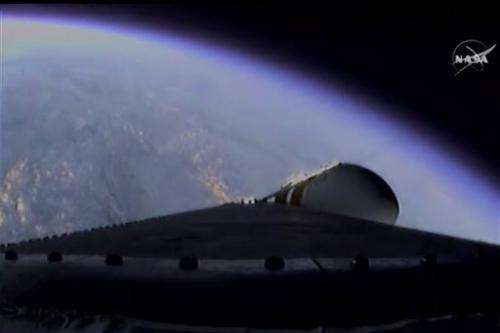
Indeed, the team working the Mars Curiosity rover tweeted a quick congrats: "We're one step closer to bootprints next to these rover tracks."
Lockheed Martin, which handled the $370 million test flight for NASA using a Delta IV rocket, already has begun work on a second Orion and plans to build a whole fleet. An asteroid redirected to lunar orbit is intended for the first stop in the 2020s, followed by Mars in the 2030s. Monthslong journeys would include habitats as well as the four-person capsules, which are bigger than the old-style Apollo and considerably enhanced.
"Everybody wants to go to Mars," astronaut Rex Walheim noted, "and it's important to go there to figure out what happened to Mars and establish our presence on another planet to become a multiplanetary species."
The atmosphere surrounding Friday's smooth sunrise launch—one day late because of wind and valve trouble—was a throwback to the shuttle-flying days, but considerably more upbeat than that last 2011 mission. Walheim was on board for that mission and welcomed all the excitement returning to Kennedy Space Center.
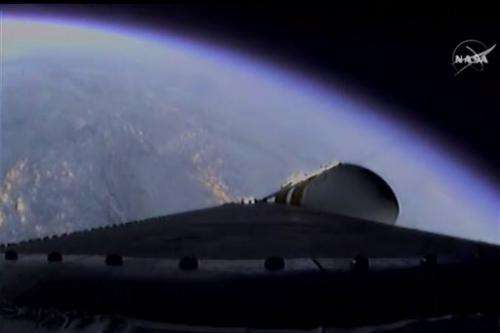
This Orion—serial number 001—lacked seats, cockpit displays and life-support equipment, but brought along bundles of toys and memorabilia: bits of moon dust; the crew patch worn by Sally Ride, America's first spacewoman; a Capt. James Kirk doll owned by "Star Trek" actor William Shatner.
Officials noted that in two days, it will be exactly 42 years since Apollo 17 launched.
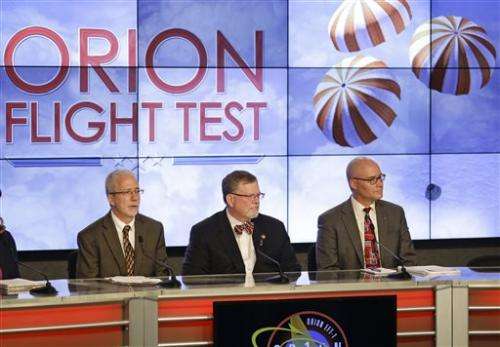
"Here we are again now, the United States leading exploration out into the solar system," Geyer told reporters.
Before the news conference ended, a rainbow appeared in the sky.
© 2014 The Associated Press. All rights reserved.





















